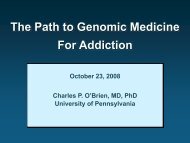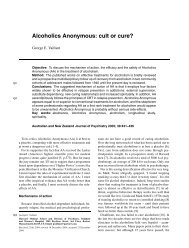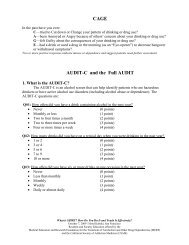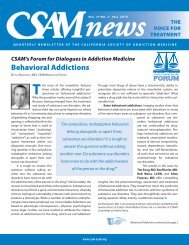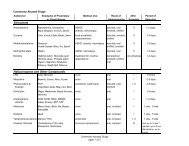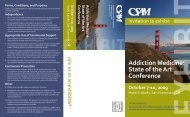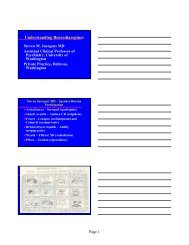SAN FRANCISCOMEDICINE - California Society of Addiction ...
SAN FRANCISCOMEDICINE - California Society of Addiction ...
SAN FRANCISCOMEDICINE - California Society of Addiction ...
You also want an ePaper? Increase the reach of your titles
YUMPU automatically turns print PDFs into web optimized ePapers that Google loves.
further acknowledged. Supported by the<br />
new Nixon White House philosophy that<br />
“no addict should have to commit a crime<br />
because he can’t get treatment,” due to<br />
the increase in the numbers <strong>of</strong> addicted<br />
Vietnam veterans returning to the United<br />
States, addiction treatment services in<br />
San Francisco increased significantly.<br />
Despite these philosophical trends,<br />
physicians were still the targets <strong>of</strong> punitive<br />
action. After the arrest <strong>of</strong> two Southern<br />
<strong>California</strong> physicians for detoxifying<br />
heroin addicts with Valium in an outpatient<br />
medical setting, Dr. Jess Bromley<br />
recommended that we start a <strong>California</strong><br />
pr<strong>of</strong>essional society. By aligning with the<br />
<strong>California</strong> Medical Association (CMA), we<br />
could associate nationally with the AMA,<br />
an essential step toward overcoming<br />
the organized medical establishment’s<br />
resistance to efforts to get nonalcohol<br />
addictions accepted as diseases.<br />
One <strong>of</strong> the key organizers <strong>of</strong> the<br />
<strong>California</strong> <strong>Society</strong> <strong>of</strong> <strong>Addiction</strong> Medicine<br />
(CSAM) was Dr. Max Schneider, a Southern<br />
<strong>California</strong> gastroenterologist. Treating<br />
cirrhosis <strong>of</strong> the liver with associated<br />
GI bleeds, he became concerned that the<br />
existing medical system <strong>of</strong>fered little to<br />
treat the causative disease <strong>of</strong> alcoholism.<br />
In fact, all <strong>of</strong> the founders <strong>of</strong> CSAM were<br />
motivated by the principle that it makes<br />
no medical sense to treat the complications<br />
<strong>of</strong> a disease and not treat the underlying<br />
chronic medical illness, whether it is<br />
a disease <strong>of</strong> the brain—like addiction—or<br />
a disease <strong>of</strong> the pancreas—like diabetes.<br />
As an appointee to the AMA committee<br />
on alcoholism, I introduced the<br />
disease model <strong>of</strong> addiction to the AMA<br />
committee in 1976. I coined the term<br />
“addiction medicine,” and after much<br />
debate it was accepted. Also at that time,<br />
Dr. Douglas Talbott, who pioneered the<br />
treatment <strong>of</strong> addicted physicians, introduced<br />
the term “addictionology.”<br />
In 1983, individuals in the addiction<br />
field met at the Kroc Ranch in <strong>California</strong><br />
and agreed that a single organization,<br />
what has evolved into the American<br />
<strong>Society</strong> <strong>of</strong> <strong>Addiction</strong> Medicine, would<br />
represent the field. Five years later, ASAM<br />
gained acceptance in the AMA House <strong>of</strong><br />
Delegates as a specialty society with Dr.<br />
Bromley as the ASAM delegate and me as<br />
alternate delegate (ASAM, 2006).<br />
The AMA accepted the motion introduced<br />
by ASAM that all drug dependencies,<br />
including alcoholism, are diseases<br />
and that medical practitioners should<br />
base their medical practice on the disease<br />
model <strong>of</strong> addiction. When ASAM<br />
expanded its focus to include cigarette/<br />
nicotine addiction, with its associated<br />
morbidity and mortality, the AMA granted<br />
specialty status with the code <strong>of</strong> “ADM”<br />
after introduction <strong>of</strong> a resolution by the<br />
<strong>California</strong> Medical Association in 1990<br />
(ASAM 2006).<br />
We had hoped primarily to gain acceptance<br />
by organized medicine in the<br />
U.S. for addiction medicine (the study<br />
and treatment <strong>of</strong> addictive disease). The<br />
specialty now is recognized throughout<br />
the world; the International <strong>Society</strong> <strong>of</strong><br />
<strong>Addiction</strong> Medicine (ISAM) has been<br />
meeting regularly since its formation in<br />
Palm Springs in 1999. The significance <strong>of</strong><br />
the disease model <strong>of</strong> addiction is now fully<br />
acknowledged by mainstream medicine,<br />
to the extent <strong>of</strong> gaining parity with other<br />
medical issues in health care reform.<br />
A 2000 CalData study showed that<br />
every dollar spent on treatment saved<br />
an estimated seven dollars in health and<br />
social costs (CalData study, CSAM News<br />
2000). Kaiser Permanente researchers<br />
have also found strong evidence <strong>of</strong> cost<br />
savings (Parthasarathy et al 2001). Meanwhile,<br />
the criminal justice system and<br />
community and school-based prevention<br />
programs have not proved sufficient to<br />
turn the tide <strong>of</strong> substance abuse. <strong>Addiction</strong><br />
medicine has encouraged medicine<br />
to become a major force in dealing with<br />
this public health issue: 100 percent <strong>of</strong><br />
alcoholics and addicts will at some time<br />
interface with the medical system.<br />
However, despite compelling evidence<br />
for a decade demonstrating excellent<br />
cost-benefit outcomes for addiction<br />
as a brain disease emphasizing prevention,<br />
intervention, and treatment, the<br />
battle to implement parity by the sociological<br />
and political structure <strong>of</strong> the U.S.<br />
remains to be won. As President Obama<br />
stated in his book, The Audacity <strong>of</strong> Hope,<br />
“past history is not dead and buried, it<br />
is not even dead.” <strong>Addiction</strong> medicine’s<br />
history demonstrates to the next medical<br />
generation that it can both continue<br />
the battle to help the suffering alcoholic<br />
and addict and further the integration<br />
<strong>of</strong> addiction medicine with mainstream<br />
medicine.<br />
David E. Smith, MD, currently serves<br />
as chair <strong>of</strong> addiction medicine at the Newport<br />
Academy and as medical director <strong>of</strong><br />
Center Point. He is an adjunct pr<strong>of</strong>essor at<br />
UCSF and a past president <strong>of</strong> the American<br />
<strong>Society</strong> <strong>of</strong> <strong>Addiction</strong> Medicine and the<br />
<strong>California</strong> <strong>Society</strong> <strong>of</strong> <strong>Addiction</strong> Medicine.<br />
He is the founder <strong>of</strong> the Haight Ashbury<br />
Free Medical Clinic.<br />
References<br />
ASAM. 2006. Turning points in<br />
establishing the medical specialty <strong>of</strong><br />
addiction medicine. http://www.asam.<br />
org/CMS/images/PDF/Certification/<br />
TurningPoints.pdf.<br />
CalData study. CSAM News. 2000.<br />
Heilig S. 2009. David Smith: Pioneering<br />
community-based health care. San<br />
Francisco Medicine. 2009; 15.<br />
Katcher BS. 1993. Benjamin Rush’s<br />
educational campaign against hard drinking.<br />
Amer J Public Health. 83(2):273-281.<br />
Knudsen HK. 2009. Barriers to treating<br />
alcohol and drug problems among<br />
adolescents. Robert Wood Johnson Foundation/Substance<br />
Abuse Policy Research<br />
Program. www.saprp.org/KnowledgeAssets/Knowledge_Detail.cfmKAID=20.<br />
Kunz KB and Gentilello LM. 2009.<br />
Landmark recognition for addiction<br />
medicine. <strong>Addiction</strong> Pr<strong>of</strong>essional. 2009;<br />
12-17.<br />
Obama B. 2006. The Audacity <strong>of</strong> Hope.<br />
New York: Crown Publishers<br />
Parthasarathy S, Weisner C, Hu TW,<br />
and Moore C. 2001. Association <strong>of</strong> outpatient<br />
alcohol and drug treatment with<br />
health care utilization and cost: Revisiting<br />
the <strong>of</strong>fset hypothesis. Journal <strong>of</strong> Studies on<br />
Alcohol. 2001; 62(1):89-97.<br />
Silkworth W. 1937. Alcoholism as a<br />
manifestation <strong>of</strong> allergy. Medical Record.<br />
1937; 145:249-251.<br />
www.sfms.org June 2010 San Francisco Medicine 15




